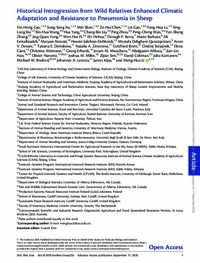Authors:
Yin-Hong Cao
Song-Song Xu, Song-Song Xu, Min Shen, Min Shen, Ze-Hui Chen, Ze-Hui Chen, Lei Gao, Lei Gao, Feng-Hua Lv, Feng-Hua Lv, Xing-Long Xie, Xing-Long Xie, Xin-Hua Wang, Xin-Hua Wang, Hua Yang, Hua Yang, Chang-Bin Liu, Chang-Bin Liu, Ping Zhou, Ping Zhou, Peng-Cheng Wan, Peng-Cheng Wan, Yun-Sheng Zhang, Yun-Sheng Zhang, Jing-Quan Yang, Jing-Quan Yang, Wen-Hui Pi, Wen-Hui Pi, Eer Hehua, Donagh P. Berry, Mario Barbato, Ali Esmailizadeh, Maryam Nosrati, Hosein Salehian-Dehkordi, Hosein Salehian-Dehkordi, Mostafa Dehghani-Qanatqestani, Arsen V. Dotsev, Tatiana E. Deniskova, Natalia A. Zinovieva, Gottfried Brem, Ondrej Stepanek, Elena Ciani, Christina Weimann, Georg Erhardt, Joram Mwashigadi Mwacharo, Abulgasim Ahbara, Han Jianlin, Han Jianlin, Olivier Hanotte, Olivier Hanotte, Olivier Hanotte, Joshua M. Miller, Zijian Sim, Zijian Sim, David W. Coltman, Juha Kantanen, Michael W Bruford, Michael W Bruford, Johannes A Lenstra, James W. Kijas, Meng-Hua Li, Meng-Hua Li
How animals, particularly livestock, adapt to various climates and environments over short evolutionary time is of fundamental biological interest. Further, understanding the genetic mechanisms of adaptation in indigenous livestock populations is important for designing appropriate breeding programs to cope with the impacts of changing climate. Here, we conducted a comprehensive genomic analysis of diversity, interspecies introgression, and climate-mediated selective signatures in a global sample of sheep and their wild relatives. By examining 600K and 50K genome-wide single nucleotide
polymorphism data from 3,447 samples representing 111 domestic sheep populations and 403 samples from all their
seven wild relatives (argali, Asiatic mouflon, European mouflon, urial, snow sheep, bighorn, and thinhorn sheep), coupled
with 88 whole-genome sequences, we detected clear signals of common introgression from wild relatives into sympatric domestic populations, thereby increasing their genomic diversities. The introgressions provided beneficial genetic variants in native populations, which were significantly associated with local climatic adaptation. We observed common introgression signals of alleles in olfactory-related genes (e.g., ADCY3 and TRPV1) and the PADI gene family including in particular PADI2, which is associated with antibacterial innate immunity. Further analyses of whole-genome sequences showed that the introgressed alleles in a specific region of PADI2 (chr2: 248,302,667–248,306,614) correlate with resistance to pneumonia. We conclude that wild introgression enhanced climatic adaptation and resistance to pneum
Citation:
Yin-Hong Cao, Song-Song Xu, Min Shen, Ze-Hui Chen, Lei Gao, Feng-Hua Lv, Xing-Long Xie, Xin-Hua Wang, Hua Yang, Chang-Bin Liu, Ping Zhou, Peng-Cheng Wan, Yun-Sheng Zhang, Jing-Quan Yang, Wen-Hui Pi, Eer Hehua, Donagh P. Berry, Mario Barbato, Ali Esmailizadeh, Maryam Nosrati, Hosein Salehian-Dehkordi, Mostafa Dehghani-Qanatqestani, Arsen V. Dotsev, Tatiana E. Deniskova, Natalia A. Zinovieva, Gottfried Brem, Ondrej Stepanek, Elena Ciani, Christina Weimann, Georg Erhardt, Joram Mwacharo, Abulgasim Ahbara, Han Jianlin, Olivier Hanotte, Joshua M. Miller, Zijian Sim, David W. Coltman, Juha Kantanen, Michael W Bruford, Johannes A Lenstra, James W. Kijas, Meng-Hua Li. (1/3/2021). Historical Introgression from Wild Relatives Enhanced Climatic Adaptation and Resistance to Pneumonia in Sheep. Molecular Biology and Evolution, 38 (3), pp. 838-855.
Keywords:
climate adaptation
ovine
genome-wide snps
whole-genome sequences

